This year’s Royal Academy Summer Exhibition sees architecture integrated throughout the show for the first time, a curatorial shift that brings fresh juxtapositions but leaves technical work struggling to compete for attention, writes Mary Richardson
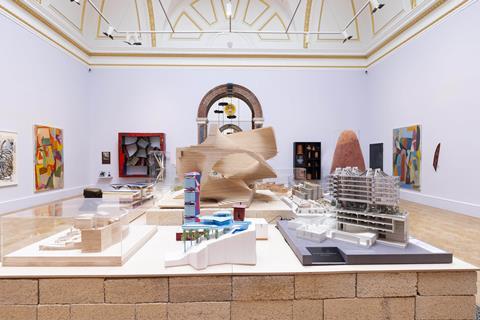
This year’s RA Summer Exhibition is the 257th, and the first in which the architecture is mixed in among the other artworks instead of having its own designated space – a development that doesn’t serve it well.
It’s perhaps surprising that this is the year that architecture has been ‘mixed in’ with the other artworks, given that the coordinator of the 2025 exhibition is a celebrated architect: Farshid Moussavi of Farshid Moussavi Architecture and formerly of Foreign Office Architects (FOA). Moussavi was joined in the curation of the show’s architecture by her fellow Royal Academicians Tom Emerson and Stephanie Macdonald of 6a architects.
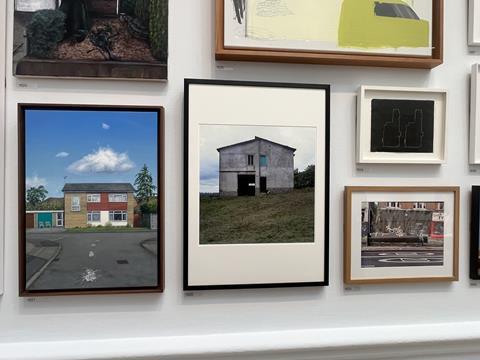
Probably because the lead curator is an architect, many images of buildings – in addition to the usual architectural drawings and models – have found their way into the selection. There is a distinct genre of mid-century Modernist ‘suburban estate’ paintings represented. And a lot of ruins. Declinism is a mood of the show. But not the only mood. There is joy here too: served via exuberant colour, abstraction and pattern, and the inevitable amateur images of nature, painted with love.
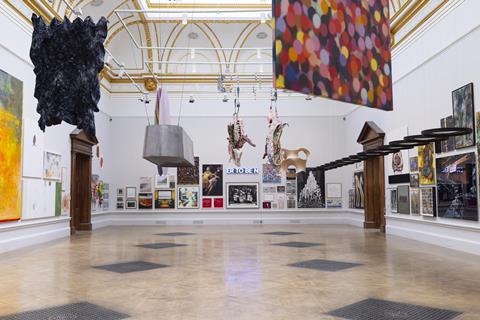
It is a well-hung show, from the very first room you enter, which creates maximum impact with monochrome-only works. Gallery III is full of bold suspended works that manage not to fight with the wall-hung pieces. Among these is the Thunder and Şimşek installation by Jayden Ali (of JA-Projects), a powerful and poignant piece consisting of huge metal pans/vessels, which explores the multiple legacies of colonialism. It was represented in maquette form at last year’s show, and is now executed full size.
Dialogues
The official theme of this year’s show is ‘Dialogues’. Moussavi explains this idea came “from the recognition that we are living through a time of increasing polarities – social, political and cultural. In the face of such growing fragmentation, the aim of this year’s exhibition is not to dwell on division, but instead to be inspired by art’s capacity to forge dialogues about, and heighten our sensitivity towards, societal concerns such as ecology, survival, and the ways in which we live together”.
Notably, this is a similar ambition to that espoused for this year’s iteration of that other establishment summer art staple, the Serpentine Pavilion. And it’s a pretty lofty aspiration for the grab bag that is the Summer Exhibition…

The new in-the-mix approach for the architectural contributions is couched in positive terms: “For the first time, architecture is integrated with the artworks throughout the show, creating conversations with art rather than being confined to its own space”, says the RA.
However, these conversations feel one-sided, with the more immediately emotionally and aesthetically engaging artworks drowning out the quieter, more technical architectural drawings. The art shouts while the architecture speaks quietly.
There is strong theming at work in the hang. Moussavi says, “Throughout we have tried to find common preoccupations between artists and architects.” As an example, she draws attention to similarities between academician Jock McFadyen’s painting of a damaged modernist building Somewhere in Ukraine and two Tess Jaray abstract acrylic paintings next to it, in which the artist plays with contrasts between dark and light.
The three form part of a grouping of works in Room III that has a clear architectural theme. The group also includes a print by Alex Currie of Park Hill flats in Sheffield, and an axonometric line drawing of Níall McLaughlin’s new museum in Leiden.
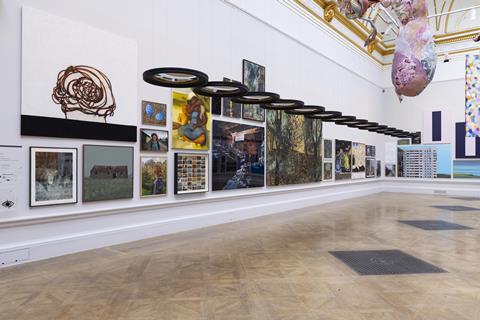
Moussavi says of the McFadyen work, “For an architect, the elevation or the façade of a building is like working on a canvas. How you puncture the windows; their proportions; it all affects how you perceive a building. I find quite a bit of common ground between that building [and the paintings next to it]. And we see these kinds of dialogues across the exhibition.”
Lack of visual impact
Visually, this group of works does indeed look harmonious together, and the pieces could certainly be described as being ‘in dialogue’ with each other in the broadest sense, i.e. that they have similar subject matter. But the architectural drawings are the losers in these arrangements. Surrounded by paintings of buildings, abstract prints, and photos of the urban environment, architectural drawings are rendered pictorial rather than technical – and, on those terms, lack visual impact in comparison to the artworks.

Then, in a show of 1,700 items, it’s all too easy for the gaze to pass on by. Plus, in the salon hang – which admittedly feels less vertiginous than in some previous years – the odd architectural drawing is simply just too high to be seen at all clearly.
Perhaps it is because of these difficulties that it is the 3D architecture pieces that are the most memorable this year.

Metropolitan Workshop’s model of Station Quarter, part of the Carpenters Estate regeneration scheme in Stratford, is particularly striking. The impressionistic model has been carved from a fallen sequoia tree by a trainee at the Building Crafts College in Stratford, with brass labels on it setting out ‘asks’ derived from the resident consultation process.
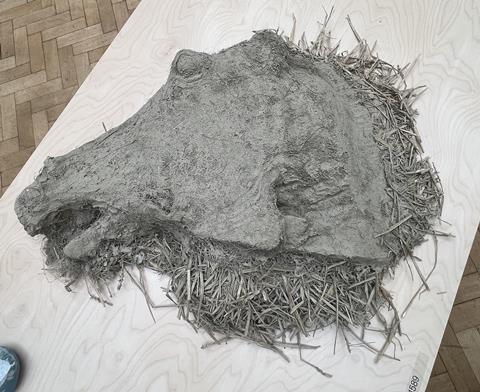
Another notable piece is a light earth copy of a Parthenon chariot horse’s head by Maria Lisogorskya, Kaye Song, Experimental Foundation and Sitterwerk Foundation, shown by Assemble. There’s a lot going on here: the symbolism of the horse in ancient Greece and Elgin Marbles problematics… all rendered in clay and straw.
Also on show is We Are More (A Community of Colours Sourced from Along the Mersey Estuary), a set of dyes made from natural pigments by Frances Disley in collaboration with 6a architects for Tate Liverpool. Sixty rather lovely muted colours have been painstakingly created from plants like ragwort and buddleia, and tested on render samples.

Be sure not to miss Hrōst by 51 architecture. This 6m tall pavilion is in the Lovelace Courtyard between the two Royal Academy Buildings, Burlington House and Burlington Gardens, in an area restricted to RA School students. However, members of the public can see it from the Weston Bridge viewing platform.
Hrost is an Old English word meaning both the wooden frame of a roof and a roost. The tall, rustic wooden structure is a prototype multispecies roost designed with advice from a range of conservation charities. It contains owl and kestrel boxes, bat loft, invertebrate nesting area, hibernaculum (where amphibians and reptiles can hibernate), and an overhanging roof where house martins can nest: a veritable contemporary ark, if the targeted inhabitants take to it – and don’t eat each other.
Explanation required
There’s another problem with the architecture exhibits. But this is a longstanding one. I’m reminded of it overhearing Stephanie Macdonald describe the story and rationale behind 6a’s model for its Tate Liverpool redesign.
Her explanation brings the plywood to life. And that’s the issue: if they are to engage the public successfully, architectural models and drawings need reasonably extensive accompanying explanatory text in a way that prints, paintings and sculptures just don’t.

It’s understandable that, with so many works in the show, the RA should try to keep down costs and visual clutter with limited labelling. But in order for gallery-goers to really understand them, the architectural models and drawings would benefit from much lengthier captions than the brief catalogue allows.
Surely QR codes would offer a basic means to link to more information, even if just on each designer’s own website? The added value for the architectural exhibits would make the ‘risk’ inherent in a thousand live links worthwhile: and visitors could proceed on the basis of caveat clicker.
It is noticeable that the Foster + Partners models – such as Spencer de Grey’s models of the D Y Patil University Centre of Excellence in Mumbai, and Lord Foster’s of the Zayed National Museum, Abu Dhabi – are very comprehensively labelled. And all the better for it.
Superstar academicians
Emerson and Macdonald invited architectural submissions that explore how architecture can bring society together and reconnect with nature and its entangled global past and present – a theme that’s broad enough to encompass almost anything. And all the architectural RA superstars have sent along something to go in the show.

Connection to the theme is, as ever with the Summer Exhibition, more evident in some submissions than others.
Mixing the architecture in with the art was an interesting idea. Worth a try. I don’t think it worked. But that doesn’t mean the experiment wasn’t worth doing.
Good year to visit
Despite this misgiving, I think for readers of Building Design, this is a good year to visit the summer show. For you are the very people who will understand and appreciate the architectural drawings even when they’re fighting losing battles with overpowering up-close artworks.
And there are so many beautiful drawings in there – by everyone from Material Cultures to Sir David Chipperfield – that are well worth seeking out and appreciating. You too might well be the target audience for all those paintings of buildings.
There’s a decent amount of not bad art this year. And it is well hung.
Postscript
The RA Summer Exhibition runs from 17 June to 17 August at the Royal Academy, Piccadilly, London W1J 0BD. Tuesday to Sunday, 10am – 6pm, Friday 10am – 9pm.
The RA is holding a Summer Exhibition Architecture Afternoon from 2–6pm on Friday 20 June, where you can hear Stephanie Macdonald and Tom Emerson discuss the show and their approach to curating the architectural works.


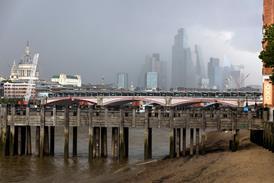
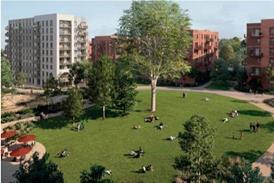
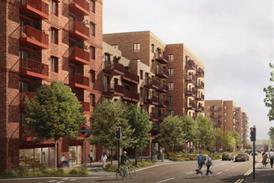











No comments yet